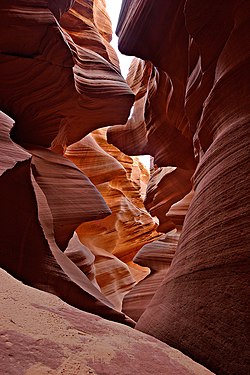This is an old revision of this page, as edited by Malcolm (talk | contribs) at 23:14, 15 February 2007 (→Historical examples: rm POV). The present address (URL) is a permanent link to this revision, which may differ significantly from the current revision.
Revision as of 23:14, 15 February 2007 by Malcolm (talk | contribs) (→Historical examples: rm POV)(diff) ← Previous revision | Latest revision (diff) | Newer revision → (diff)
A Flash Flood is a rapid flooding of geomorphic low-lying areas (washes), rivers and streams, caused by the intense rainfall associated with a thunderstorm, or multiple training thunderstorms. Flash floods can also occur when ice jams block the normal course of a river, or when a man-made structure, such as a dam, collapses, e.g., the Johnstown Flood of 1889. Flash flooding occurs when the ground becomes saturated with water that fell so quickly that it could not be absorbed. The runoff collects in low-lying areas and rapidly flows downhill. Flash floods most often occur in normally dry areas that have recently received precipitation, but may be seen anywhere downstream from the source of the precipitation (even dozens of miles from the source).
The U.S. National Weather Service gives the advice "Turn Around, Don't Drown" in reference to flash floods; that is, it recommends that people get out of the area of a flash flood, rather than trying to cross it. Most people tend to underestimate the dangers of flash floods.
Flash floods are extremely dangerous because of their sudden nature. Being in a vehicle provides little to no protection against being swept away; it may make people overconfident and less likely to avoid the flash flood. More than half of the fatalities attributed to flash floods, are people swept away in vehicles when trying to cross flooded intersections . As little as 6 inches of water can be enough to carry away most SUV-sized vehicles. In the United States, the National Weather Service (part of NOAA) reported in 2005 that, using a national 30-year average, more people die yearly in floods (127 on average) than by lightning (73), tornadoes (65), or hurricanes (16).
The desert southwestern U.S. is especially dangerous for both hikers and vehicles from the sudden onslaught of water from isolated thunderstorms. These rains fill poorly-absorbent and often claylike dry riverbeds. A moving flood will usually be headed by a debris pile that may have wood branches and/or logs. Deep slot canyons can be especially dangerous to hikers as they may be flooded by a storm that occurs on a mesa miles away, sweeping through the canyon, making it difficult to climb up and out of the way to avoid the flood. Valley roads frequently cross dry river and creek beds without bridges. From the driver's perspective, there may be clear weather, when unexpectantly a river forms ahead of or around the vehicle in a matter of seconds.
Historical examples
- The Lynmouth disaster of August 1952 Killing at 125 people
- 1997 flash flood kills eleven in Antelope Canyon
- Boscastle flooding of 2004.
- 2006 flash flooding kills 125 in Ethiopia (requires paid subscription).
See also
References
Further Reading
- Schmittner Karl-Erich and Giresse Pierre, 1996. Modelling and application of the geomorphic and environmental controls on flash flood flow. Geomorphology 16/4:337-347.
External links
- Turn Around Don't Drown – a public education safety initiative for flash flooding
- Decision tree to choose an uncertainty method for hydrological and hydraulic modelling, choosing an uncertainty analysis for flood modelling.
- http://www.rankinstudio.com Great footage of flash floods in the arid midwest heading down dry washes after heavy rain.